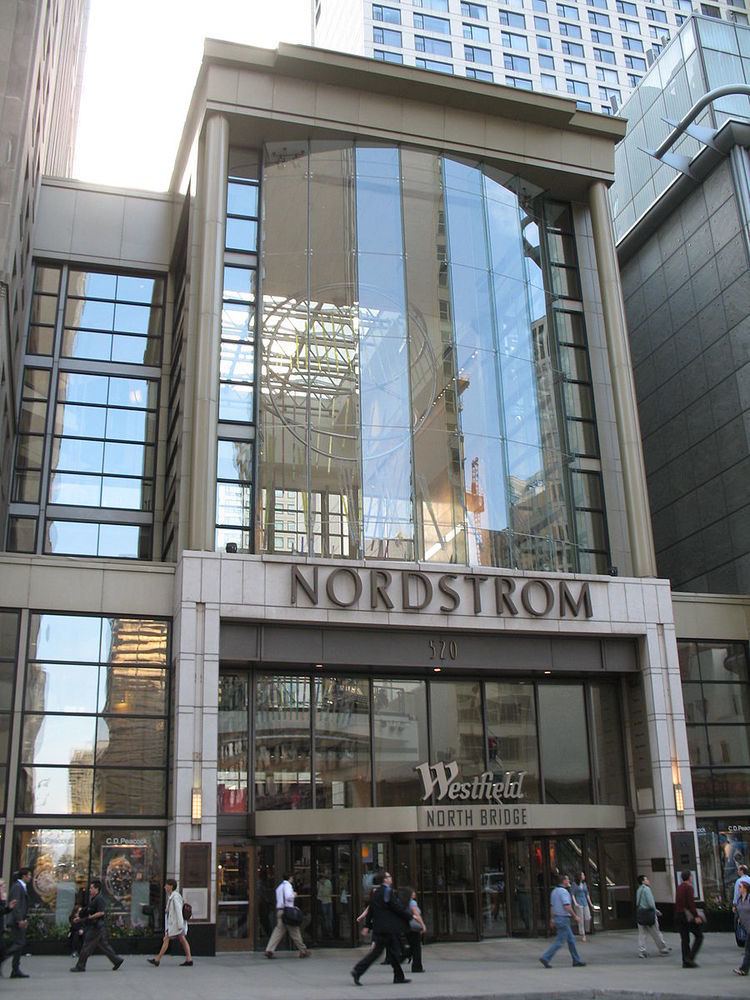Developer The John Buck Co. Owner Macerich | Opening date 2000 Management Macerich No. of stores and services 43 | |
 | ||
The Shops at North Bridge, once known as Westfield North Bridge, is an upscale, urban retail-entertainment district in Chicago, Illinois, located at 520 N. Michigan Avenue. Its anchor store is a Nordstrom; other tenants include Lego Store and Sephora. Its name alludes first to its location within the nine-block North Bridge complex and to the literal distinction of the shopping center incorporating four-level enclosed bridges over both east Grand Ave, and north Rush Street. When Westfield owned the mall, confusingly, "Westfield North Bridge" typically refers only to the enclosed mall, but Westfield holds a retail management contract for the entire North Bridge complex, which includes another multistory retail complex (two blocks north, at 600 N. Michigan Avenue) built in 1995 and street-level retail spaces throughout the complex. North Bridge also includes five hotels (three Hilton, two Marriott), three parking garages, and two office buildings, housing the American Medical Association and Euro RSCG. Upon opening, it also included a DisneyQuest "urban amusement park," since converted into a furniture store.
In 2003, The Westfield Group acquired the shopping center, and renamed it "Westfield Shoppingtown North Bridge," dropping the "Shoppingtown" name in June 2005.
However, The Macerich Company acquired the mall in January 2008, therefore returning to the mall's original name, "The Shops at North Bridge." It is Macerich's first mall in Illinois, in an effort to acquire high-end retail malls.
Architecture and art
The shopping mall occupies the lower floors of an unusual building. The Art Deco McGraw-Hill Building, built in 1928 and a designated City of Chicago historic landmark, was demolished but its facade dismantled, cleaned, stored, and re-hung on the exterior of a new building on the same site. The Conrad Hotel, a luxury affiliate of Hilton Hotels, occupied the upper floors of the building, until it was renamed the Gwen in 2015 and operated by Starwood Hotels (The hotel opened under the Le Meridien flag and was converted in 2006.) The mall also occupies a topographically unusual site, as Michigan Avenue at this location is elevated, gently sloping back down to ground level from its bi-level bridge over the Chicago River. Furthermore, Nordstrom occupies floors one through four of a full-block building one block behind Michigan Avenue, at the southwest corner of N. Rush Street and E. Grand Avenue. The only location available for a prominent entry on Michigan Avenue was over Grand Avenue, where the developer built an 80-foot-tall (24 m) atrium between the former McGraw-Hill Building and the existing Marriott Hotel. The mall curves southwest through the building and ramps up several feet, accommodating a rise in Grand Avenue below, then spans Rush Street to meet Nordstrom. Under development agreements, no leasable retail space occupies the actual bridges. Street-level retail space also exists along the ground-level streets underneath the mall, whose first floor is actually quite high above ground level. The complex's architects were Anthony Belluschi Associates, with OWP&P, Farr Associates (preservation consultant), and Callison (Nordstrom building). The McGraw-Hill Building's original architect was Thielbar and Fugard.
The mall also has an ambitious artistic program for a speculative commercial building. The main atrium is crowned by a 54' ring of dichromic glass, which refracts and scatters incoming light. Several decorative limestone panels of Roman gods, carved by sculptor Gwen Creighton Lux and formerly on the north facade of the McGraw-Hill Building, were installed on the first floor of the atrium. A changing selection of Lego sculptures within the mall draws attention to the presence of Lego.
Two other structures within the North Bridge complex are architecturally notable. The construction of the AMC Loews 600 North Michigan building also created controversy, as it included the demolition of the Arts Club of Chicago (interior by Mies van der Rohe, 1951), a private art gallery. Construction proceeded after the Arts Club relocated its famed floating staircase to a new building. North Bridge's oldest building is the American Medical Association office building at 515 N. State Street, the first American building designed by architect Kenzō Tange (in 1990).
